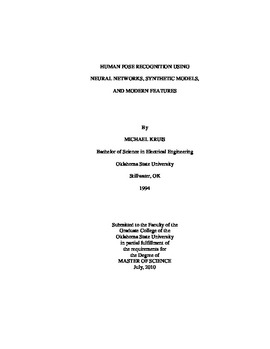| dc.contributor.advisor | Fan, Guoliang | |
| dc.contributor.author | Kruis, Michael | |
| dc.date.accessioned | 2014-04-17T20:08:50Z | |
| dc.date.available | 2014-04-17T20:08:50Z | |
| dc.date.issued | 2010-07-01 | |
| dc.identifier.uri | https://hdl.handle.net/11244/10232 | |
| dc.description.abstract | Our goal in this research is to compare modern image feature vectors with traditional image feature vectors in the task of human pose recognition. Recently newer image feature vectors such as Histograms of Oriented Gradient (HOG's) and Speeded Up Robust Features (SURF) have been successfully utilized for object recognition in images. The value of these newer feature vectors compared to traditional feature vectors for pose recognition has not been fully addressed. Our study uses synthetic human animation models, neural networks, and a variety of image feature vectors for pose recognition. In this approach feature vectors and pose information are extracted from five 3D human gait animations created from five human models. We define 10 poses in a full walking cycle and 12 views around the human model. Ten images are extracted for each pose, view and model, resulting in total 6000 images (3600 for training and 2400 for testing). Features are divided into dense and sparse representations. The former one includes binary silhouette, distance transform of silhouette, HOG's, and Zernike moments, and the latter one embraces contour distance, contour angle, and SURF. Moreover, three SURF related fixed length feature vectors are developed. A set of neural networks are then trained to match the feature/pose relationship specified by the extracted data. The HOG feature proved to be the best overall feature for pose recognition with the highest pose recognition accuracy. High accuracy for SURF features could not be achieved with fixed length SURF features. High accuracy for individual views and specific SURF feature lengths was shown. The silhouette feature is shown to be robust and effective in general. Zernike moments are compact and highly accurate at pose recognition, but required a long computational time. Contour features were low in accuracy but easy to extract and compact. The silhouette distance transform did not perform significantly better than the silhouette. We also discuss the advantages and disadvantages of individual feature in this work. | |
| dc.format | application/pdf | |
| dc.language | en_US | |
| dc.publisher | Oklahoma State University | |
| dc.rights | Copyright is held by the author who has granted the Oklahoma State University Library the non-exclusive right to share this material in its institutional repository. Contact Digital Library Services at lib-dls@okstate.edu or 405-744-9161 for the permission policy on the use, reproduction or distribution of this material. | |
| dc.title | Human Pose Recognition Using Neural Networks, Synthetic Models, And Modern Features | |
| dc.type | text | |
| dc.contributor.committeeMember | Chandler, Damon | |
| dc.contributor.committeeMember | Hagan, Martin | |
| osu.filename | Kruis_okstate_0664M_11046.pdf | |
| osu.college | Engineering, Architecture, and Technology | |
| osu.accesstype | Open Access | |
| dc.description.department | School of Electrical & Computer Engineering | |
| dc.type.genre | Thesis | |
| dc.subject.keywords | modern features | |
| dc.subject.keywords | neural networks | |
| dc.subject.keywords | pose recognition | |
